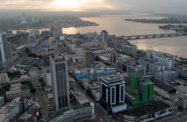A strong performance from traditional industries such as agriculture and increased spending in infrastructure and service sectors allowed Kenya to notch up solid growth in 2014, while a rebasing exercise in September has helped better capture the economy’s true size.
Kenya is on course to post growth figures of 5.3%-5.5% for 2014 according to government estimates. Finance Minister Henry Rotich said in December that infrastructure spending would help lift economic growth to about 6.5% in 2015, against a previous forecast of 6.4% percent.
This comes after a recalculation boosted GDP by 25% in 2013, from KSh3.8trn ($41.3bn) to KSh4.76trn ($51.7bn), earning Kenya middle-income-country status and a place on the list of the top 10 African economies.
Aside from the GDP revision, the economy received a timely boost from falling energy costs later in the year. Hydrocarbons account for some 20% of Kenya’s total imports. Lower utilities and transport charges, combined with reduced costs in industry and agriculture, helped improve Kenya’s external current account deficit, which was running at 8% of GDP as of September, according to the IMF.
Lower costs a boost
The lower fuel costs helped bring down inflation for a third consecutive month in November, which slipped to just above 6% from a high of 8.4% in August as lower fuel charges made their presence felt along the supply chain. November saw a drop in costs across transport, food and utilities, according to data issued by the Kenya National Bureau of Statistics. The pattern looks set to continue into 2015, with consumers expected to feel the benefit of fuel price reductions.
The long-term outlook for inflation management should also improve as Kenya adds an additional 5000MW to its grid with much of the new output coming from geothermal and renewable sources – such as the Olkaria IV 140MW geothermal facility which began operating in October. Traditionally Kenya has been reliant on imported fuels to power its electricity generators, but a push to expand alternative generation should help limit consumer price rises.
Divisions on debt
The government’s fiscal performance has been relatively stable over recent years, although with public spending increasing to help underwrite major infrastructure projects, including the $25bn LAPPSET pipeline and port development, debt has been inching upwards. Concerns over debt levels, flagged by the IMF, prompted the central bank to offer reassurances that public debt is sustainable, after it reached 46% of GDP by mid-November.
While the government stepped up borrowing during 2014 – raising debt stocks on both the international and domestic markets, including through a $2bn eurobond – much of the funding was directed to transport and infrastructure investments. Bank governor Njuguna Ndung’u said the financial stimulus would be instrumental in boosting economic capacity.
Kenya’s debt levels are set to rise further in the coming 18 months on the back of a government commitment to increasing spending in the 2015/16 financial year by 10% year-on-year. The increase, which takes effect at the start of the fiscal year in July, will be funded largely by domestic borrowing, the Treasury said in December.
Lower borrowing costs could also act as a stimulus for Kenya’s economy. Interest rates offered by commercial banks dropped to 16% in December – their lowest level since October 2011. Further reductions in energy prices, and a subsequent dip in inflation, could see lending rates follow suit in 2015, leading to greater consumer spending and private sector investment in the year ahead.
While the government is looking to raise outlays, pre-budget forecasts suggest the state deficit will fall from an estimated 7.8% of GDP in the current financial year to 6.8% in 2015 on the back of higher earnings. The economy is expected to expand by 6.5% next year.
Exogenous pressures
The country has been susceptible to exogenous pressures, however – particularly in terms of exports and tourism. Growth in Kenya’s economy slowed in the third quarter, dented by a contraction in the tourism industry, one of the country’s main revenue earners. GDP rose 5.5% in the July-September period, compared to an expansion of 6.2% a year ago, according to official data released at the end of December.
Output from the accommodation and restaurants category shrank 14.6% from a year earlier, with the industry contracting for the seventh straight quarter.
A spate of terrorist incidents has also taken its toll on business confidence in the tourism sector. A recent report by Standard Chartered Bank concluded that fears over security were likely to hamper development in coastal regions, estimating overall economic growth of 5.6% in 2015.

